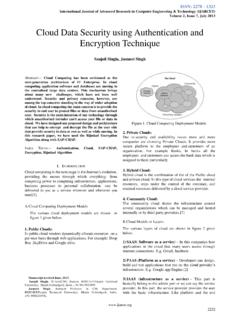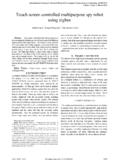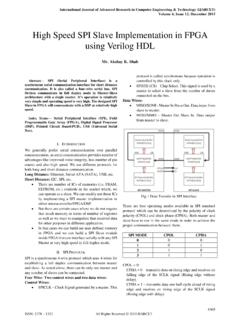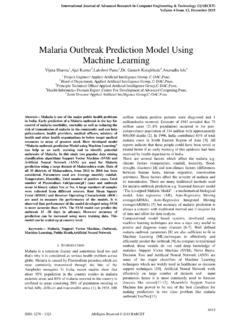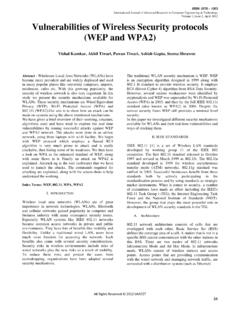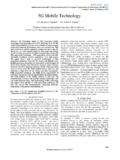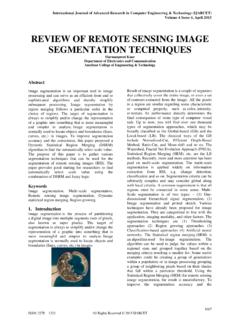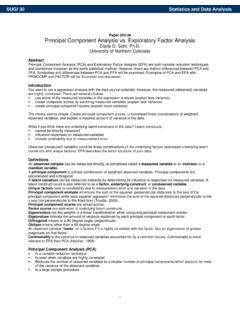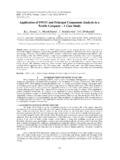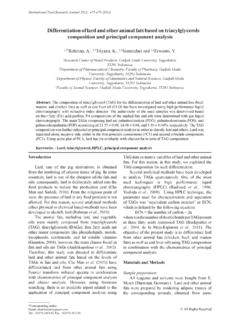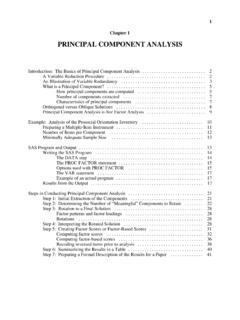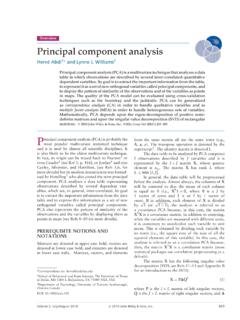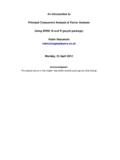Transcription of Face Recognition Using Principal Component Analysis Method
1 ISSN: 2278 1323 International Journal of Advanced Research in Computer Engineering & Technology (IJARCET) Volume 1, Issue 9, November 2012 135 All Rights Reserved 2012 IJARCET Abstract This paper mainly addresses the building of face Recognition system by Using Principal Component Analysis (PCA). PCA is a statistical approach used for reducing the number of variables in face Recognition . In PCA, every image in the training set is represented as a linear combination of weighted eigenvectors called eigenfaces. These eigenvectors are obtained from covariance matrix of a training image set.
2 The weights are found out after selecting a set of most relevant Eigenfaces. Recognition is performed by projecting a test image onto the subspace spanned by the eigenfaces and then classification is done by measuring minimum Euclidean distance. A number of experiments were done to evaluate the performance of the face Recognition system. In this thesis, we used a training database of students of Electronics and Telecommunication Engineering department, Batch-2007, Rajshahi University of Engineering and Technology, Bangladesh. Index Terms PCA, Eigenvalue, Eigenvector, Covariance, Euclidean distance, Eigenface.
3 I. INTRODUCTION Over the last ten years or so, face Recognition has become a popular area of research in computer vision and one of the most successful applications of image Analysis and understanding. Because of the nature of the problem, not only computer science researchers are interested in it, but neuroscientists and psychologists also. It is the general opinion that advances in computer vision research will provide useful insights to neuroscientists and psychologists into how human brain works, and vice versa [1].The goal is to implement the system (model) for a particular face and distinguish it from a large number of stored faces with some real-time variations as well.
4 It gives us efficient way to find the lower dimensional space. Further this algorithm can be extended to recognize the gender of a person or to interpret the facial expression of a person. Recognition could be carried out under widely varying conditions like frontal view, a 45 view, scaled frontal view, subjects with spectacles etc are tried, while the training data set covers limited views. The algorithm models the real-time varying lighting conditions as well. But this is out of scope of the current implementation. The aim of this research paper is to study and develop an efficient MATLAB program for face Recognition Using Principal Component Analysis and to perform test for program optimization and accuracy.
5 This approach is preferred due to its simplicity, speed and learning capability [2]. II. FACE Recognition PROCESS One of the simplest and most effective PCA approaches used in face Recognition systems is the so-called eigenface approach. This approach transforms faces into a small set of essential characteristics, eigenfaces, which are the main components of the initial set of learning images (training set). Recognition is done by projecting a new image in the eigenface subspace, after which the person is classified by comparing its position in eigenface space with the position of known individuals [3].
6 The advantage of this approach over other face Recognition systems is in its simplicity, speed and insensitivity to small or gradual changes on the face. The problem is limited to files that can be used to recognize the face. Namely, the images must be vertical frontal views of human faces. The whole Recognition process involves two steps: A. Initialization process B. Recognition process The Initialization process involves the following operations: i. Acquire the initial set of face images called as training set. ii. Calculate the Eigenfaces from the training set, keeping only the highest eigenvalues. These M images define the face space.
7 As new faces are experienced, the eigenfaces can be updated or recalculated. iii. Calculate distribution in this M-dimensional space for each known person by projecting his or her face images onto this face-space. These operations can be performed from time to time whenever there is a free excess operational capacity. This data can be cached which can be used in the further steps eliminating the overhead of re-initializing, decreasing execution time thereby increasing the performance of the entire system [4]. Having initialized the system, the next process involves the steps: i. Calculate a set of weights based on the input image and the M eigenfaces by projecting the input image onto each of the Eigenfaces.
8 Ii. Determine if the image is a face at all (known or unknown) by checking to see if the image is sufficiently close to a free space . iii. If it is a face, then classify the weight pattern as either a known person or as unknown. iv. Update the eigenfaces or weights as either a known or unknown, if the same unknown person face is seen several times then calculate the characteristic weight Face Recognition Using Principal Component Analysis Method Liton Chandra Paul1 , Abdulla Al Sumam2 Electronics and Telecommunication Engineering1,2 Rajshahi University of Engineering and Technology ISSN: 2278 1323 International Journal of Advanced Research in Computer Engineering & Technology (IJARCET) Volume 1, Issue 9, November 2012 136 pattern and incorporate into known faces.
9 The last step is not usually a requirement of every system and hence the steps are left optional and can be implemented as when the there is a requirement. III. EIGENFACE ALGORITHM Let a face image (x, y) be a two dimensional M by N array of intensity values. In this thesis, I used a set of image by 200 149 pixels. An image may also be considered as a vector of dimension M N, so that a typical image of size 200 149 becomes a vector of dimension 29,800 or equivalently a point in a 29,800 dimensional space. Fig-1:Conversion of M N image into MN 1 vector Step1: prepare the training faces Obtain face images I1, I2, I3, I4.
10 IM (training faces). The face images must be centered and of the same size. Step 2: Prepare the data set Each face image Ii in the database is transformed into a vector and placed into a training set S. In My example M = 34. Each image is transformed into a vector of size MN 1 and placed into the set. For simplicity, the face images are assumed to be of size N N resulting in a point in dimensional space. An ensemble of images, then, maps to a collection of points in this huge space. Step 3: compute the average face vector The average face vector ( ) has to be calculated by Using the following formula: Step 4: Subtract the average face vector The average face vector is subtracted from the original faces and the result stored in the variable , Step 5: Calculate the covariance matrix We obtain the covariance matrix C in the following manner, ( Where, A= () Step 6.)

